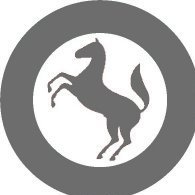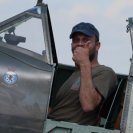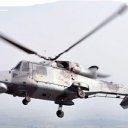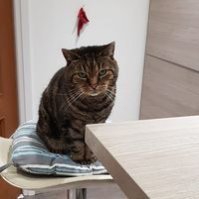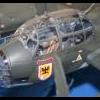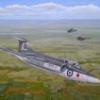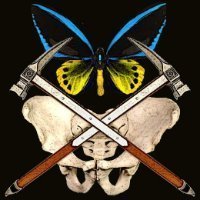Search the Community
Showing results for tags 'Matchbox'.
-
So for my part I thought I'd do two members of the Hart family, Airfix's Hawker Demon and Matchbox's Hawker Fury. From what I've seen this is a 60's vs 70's build, so in some respects this is a comparison build. First off however, a little back ground. The Hawker Demon was a fighter development of the Hart light bomber that first flew in 1933. When the Hart first entered service, it outstripped the Bulldogs and Siskins in service at the time resulting in the Air Ministry requesting a cheaper alternative to the Hawker Fury leading to development of the Hart Fighter, ultimately known as the Hawker Demon. 305 Demons were built and served with both the RAF and RAAF and were powered by various marks of the RR Kestrel engine, being armed with two forward firing Vickers machine guns and a single Lewis gun in the rear. Last produced in 1937, the Demon was briefly used in World War II in secondary roles but quickly removed from service being obsolete. The Airfix model was first produced in 1968, though my example dates from 1989. The Hawker Fury was also developed as a counterpart to the Hart, but was a single seat fighter from the off. First flown in 1931, production was hit by the Great Depression and only initially equipped two squadrons. Being the first RAF fighter to fly faster 200 mph, the Fury also had excellent aerobatic qualities and were sold to several countries with a variety engines offered, with 262 being produced in total. The RAF received a further four squadrons worth in 1936-1937, though by 1939 these had all been replaced by Gloster Gladiators and the Hurricane, which itself had its beginnings in the Fury design. Both marks were powered by variants of the Kestrel engine and carried two Vickers machine guns. The Matchbox model first came out in 1972 and can also be found under the Revell label. So onto the boxes! I believe that this was one of Matchbox's first models hence the raised panel lines, though these are very fine. At the same time, the Airfix example has a fair amount of flash and internally more austere, though the pilots appear more detailed. Below is a comparison shot: It is also clear that Matchbox came up with a better way of dealing with the front end! Not entirely sure the correct diameter for the respective craft, though I've read that the Hart family had a diameter of 10'6" and the Fury 12'6". If this is the case then they are probably about right for the models. Wish me luck!
-
Hi all,another finished build this one for the made in Britain GB,IA great nostalgia trip as I built many Matchbox kits as a kid,I enhanced the cockpit a little as can be seen in the WIP,the decals were awful due to age so the spares box got raided.Thanks for looking in.
-
Westland Wessex HAS.1 815 Sqn HMS ARK ROYAL 1965 My second build of 2016! This is the venerable Matchbox Wessex kit which first appeared in 1987 and gives options for a Mk5 or an Aussie Mk31. Since the HAS.1 and HAS. 31 are very similar, the kit is a fair starting point for use of the Wessex decals from the Xtradecal 815 Sqn set. The spares box was raided for some basic parts including a Mk.44 torpedo – not entirely accurate, but good enough for my purposes and a few other parts were scratched up, including the distinctive twin doppler mushroom aerials and a blank over the dipping sonar hatch. The kit’s intake is very basic, with a solid part over the metal gauze central section. This is such a distinctive feature of the Wessex that I had to fix it, carefully cutting out the incorrect part and replacing it with some suitable material and plastic strip. It kind-of worked, but the gauze is too large – perhaps something I can resolve in future if I find a more suitable material. I generally try to fold helicopter blades these days, both for storage/display purposes and because I think they often look much better that way. I missed out the folded tail rotor – this had been my original intention since Matchbox provide some suitable parts, but unlike the folded rotors, I decided that this option spoils the look of the finished model too much for me. Wire aerials were added to their posts using lycra thread and superglue. The final result adds another important RN aircraft to my collection. This kit is not the easiest of builds and not really recommended for beginners (Italeri’s kit is a far better option for a Mk V or HAS 3, although still a complex build). However, despite its age, it remains a viable option for those who wish to have an early Wessex in their collection. FredT
- 15 replies
-
- 27
-

-
Hi folk,s my lucky son just received twenty plus old bi-plane kits from his wife's Grandfather and some real gems there are but he kindly gave me this little beauty! So an iconic little British fighter from for many my age an iconic British kit maker.The box and content's are in great condition and the decal's look fine so when thing's get back to normal and the hols are over off we go!
-
I returned to modelling a couple of years ago and have put some builds on here but not my very first 'return build'- so here it is. I came across the Matchbox Gladi in a Charity shop for £1.50 and couldn't resist buying it. It's crude compared to the recent Airfix new mould but looks like a Gladiator to me. This was also my first attempt at rigging, I used fishing line and some isolated bits of stretched sprue. The decals are RAF Kenley 1938, couldn't resist making it look a bit tired as the Squadron will be getting Hurricane's soon and play a key role in BoB.
-
Here's my entry for a wonderful GB on yet another forum which theme is; "The name of the subject needs to have an animal in it...". The options are endless, and I decided to dive into the stash and grab one of my antiques. And I have plenty of antiques to chose from... But only one that ticks all of my -and- all of the GBs boxes... Matchbox kit? Check. 1/32 scale, and thus a nice big canvas to work with? Check. Room for improvement with minimal scratchbuilding? Check. Fits into the GB? TRRRRRIPLE CHECK BABY!! Tiger >> https://en.wikipedia.org/wiki/Tiger Moth >> https://en.wikipedia.org/wiki/Moth Tiger Moth >> https://en.wikipedia.org/wiki/Garden_tiger_moth It's three times the animal it needs to be! Yummy multicolour box content. Matchbox was doing MCP before it was cool. Eat that, Academy! Decal sheet... and they look like they might (being very cautious here...) still be usable... Trees... lovely crisp parts, no hint of flash on anything. One of the advantages of using an early boxing! I -had- one of the Revell reboxes in the stash, and that one had a lot more flash and sinkmarks. And even if it didn't have a decal option for the floatplane version, it did have a nice Dutch decal option... oh well... Classic Matchbox instructions. Gotta love them, sooo much nostalgia! But the Revell instructions I downloaded have a nice bonus; loads of rigging help! And trust me, I need all the help I can get when I'm rigging... I want to try to build this OOB as much as I can. Perhaps some harnesses and some tinkering with the engine, but nothing major. I will be working on this one whenever the Wendover build grinds to a halt for whatever reason. Good way to keep sane... (I hope) More soooon! Rob
-
1/72 scale Victor K Mk2 XL163 RAF Marham History, Construction number HP80/66 Awaiting collection 15/05/1961, delivery date 07/02/1962, to Handley-Page Ltd 14/01/1969 then Hawker Siddeley 20/05/1970 for conversion to K2 standard, l/f? 01/07/1986 to St Athan store, to St Athan 29/09/1986 for Battle Damage Repair Training as 8916M, scrapped during 12/1991 by Hanningfield Metals, Stock, Essex "An order was also sent out to the remaining Vulcan Squadron to go on to a War Footing and in a show of force 4 Vulcans were deployed to Wide-awake Airfield at Ascension Island and from there the then longest bombing missions took place. Code named Black Buck, their mission was to deny the Argentinians the use of Port Stanley Airport to their Mirage Fighter jets with 21.000LB's of bombs. One sole Vulcan XM607 Piloted by Sqn Leader Martin withers which was the standby aircraft for the first mission after its sister aircraft XM598 piloted by John Reeve suffered a ruptured windscreen seal in flight and couldn't pressurize. The first raid was successful and placed a bomb right in the centre of the runway. The missions themselves would not have happened if it wasn't for the Victors of 55 and 57 sqn refueling the Vulcan on its route as well as refueling the Victors its self, one specific Victor XL189 piloted by Bob Tuxford gave most of his fuel to XM607 and left with the bare minimum fuel to get back with." The Vulcan was over its normal maximum take-off weighteach carried, as well as extra equipment like the DASH 10 and a chemical toilet, a highly experienced Air to Air Refuelling Instructor (AARI) from the Victor tanker force who would fly the Vulcan during refuellingand fuel usage was higher than expected. As a result of the fuel demand and problems in flight with refuelling, two of the Victors had to fly further south than planned, eating into their own reserves, and one of these, the last Victor to refuel the Vulcan, was past the last refuelling bracket before turning home. Tankers had to be sent south to refuel these Victors so they could reach Ascension. A total of 11 Victors were used to support Black Buck One: XH669, XH672, XL162, XL163, XL188, XL189, XL192, XL232, XL511, XL513 and XM717 XL163, 57 Sqdn, with two wing roundels (copyright prevents posting) ( http://www.57-630sqnassoc.org.uk/forum/viewtopic.php?f=7&t=8353 ) On ascension (copyright prevents posting) ( http://www.abpic.co.uk/photo/1402175/ ) This kit was a "pig" all bent and distorted, raised panel lines etc. etc. I can't scribe but I can sand and boy did this kit need sanding AND filling, the wing needed steaming, it needed heavy duty clamps (carpenters type clamp, that's what I used them for originally! ) to pull the fuselage halves together, everything went up a few notches for tooling to build this thing. I learnt loads while building this, I am used to 1/72 fighters this thing would dwarf most 1/48th kits and even some in 1/32, the wing span is close to a 1/24 spitfire. All techniques I know for assembly went out of the window on this! I used tamiya green/grey and humbrol acrylic white as the tamiya pot looked a bit empty for this job! First go with humbrol acrylic, I must say this, I painted the white before I steamed the wing, the paint held up. The only things I added were a couple of vanes/fins on the fuselage, the centreline one just aft of the cockpit was replaced as it was severely damaged during sanding, otherwise it's out of the box. It's a simple finish but it wasn't without a great deal of effort. Decals, standard format onto gloss with 50:50 Matt/Satin humbrol topcoat, revell decal soft. Box option. This is the first of my V bomber fleet, hopefully I will be able to achieve the remaining aircraft to complete the line up. This type truly has a remarkable history.
- 41 replies
-
- 31
-

-
Hi all, I did this for the FAA group build, probably wouldn't have been my preferred choice as its not really my scale (nowhere to put the thing for starters!), but was chosen from a list of possibilities! Built OOB apart from some quickboost seats which are not quite the right mark, but look loads better than the kit seats and a bit of amertuerish scratchbuilding on the wingfold! Decals were a nightmare, very translucent and had a layer of scum on the back, had no choice but to do the best I could with them. As always notice some bits that need touching up after photographing it but anyway here it is... 894 NAS HMS Albion 1960 cheers Simon
-
Hi All, I'm in with this 1974 made in England Matchbox 1/72nd scale 3 colour kit of the British made Westland Lynx. Box Top The other side Contents The blue sprue The other blue sprue The white sprue The instructions Inside the instructions Some more of the instructions More of the same Plus this bit Then this at the end Transfers See through parts The big questions are; Should I build it sans paint since the box claims "no painting is necessary"? And should I build it as an Army helicopter or a Navy one? More to follow over... Cheers, Daniel.
-
One build on its way after my BoB Bf 109 will be finished. V-P EDIT 240915: I´ll describe in this opening post what I´m about to start building this weekend as the BoB Messerschmitt is finished. I´ll update the build as usual below in new posts. BACKGROUND: In late 1943 the loss rate of Bristol Blenheims and Dornier Do 17:s used in high altitude photo reconnaissance exceeded level of tolerance. Finnish Air Force submitted European aeronautic defence and space contractors, those that were available in those political circumstances, a tender for a fast recon plane in rapid delivery. The German Junkers Gmbh offered an off-the-shelf Junkers Ju 188 F taken from their air force, The Luftwaffe production order. The Junkers and The Luftwaffe had got into a nasty fight as The Luftwaffe had become suspicious that The Junkers had falsified their emission reports. The Junkers had claimed that "if The Luftwaffe won´t buy our planes, someone else will". Large scale export contracts to The Soviet Union had already been signed, despite The Luftwaffe opposition as they protested the export of weapons to a totalitarian country that was in war, and to make things worse, in war with Germany! Luckily they had found Swedish arms dealers to act as front men to make the deal internationally acceptable. The Luftwaffe had then put their order on hold, and the already finished planes were waiting for their instrumentation to be transformed to cyrillic alphabets before delivery to East. To this point the lucky Finns became with their tender and within weeks of acceptance the first plane was delivered to Finland. By that time winter had come and the first thing to do was to paint the Junkers in Finnish warpaint. That consisted of light blue undersides with black and green topsides. For the wintertime camouflage the green was replaced with white. Planes also had the eastern front yellow recognition band around fuselage and wingtip undersides. BACK TO REAL LIFE, eh, back to modelling miniature warplanes, that is... When I was a real kid I was very tempted by the Matchbox Junkers Ju 188 boxart. It had the sense of speed and showed the elegant purposefulness of the plane. I will build the kit out of the box, legs up as it would be in flight. Sadly I don´t have the original Matchbox stand left so will use an old Frog one. My kit may also lack its crew but in that case I have an almost-dumped-to-the-bin Airfix Ju 88 that can spare its tiny figures. As the plane was purchased for high speed and altitude overland, it won´t need external bomb racks or fuel tanks. Thanks to Matchbox oversimplifying things I shall do my first experiments with Microscale Klear, if I try to open the ventral gunners windows that are solid plastic in the kit. Likewise the camera openings too. I haven´t taken pics of the kit yet but here´s a copy of InSCALE 72 decal sheet instructions that shows what kind of Finnish warpaint I shall apply to Ju 188 (JK:s 268 and 260). The greens will be white for winter camouflage. I thought I´d alter the plane code to JJ-something as there has never been such code in use here, though it might have retained the JK-code too. Regards, V-P
- 26 replies
-
- 2
-

-
- whif
- Finnish Air Force
-
(and 2 more)
Tagged with:
-
This one has been sitting on the window sill for years. And I just love the Light Stone/Dark Green of these HMS Bulwark Wessex's. Original Matchbox (box buried in the stash some where so will have to get it out later.) KUTA has literally given me a KUTA to finish some of these that have been sitting around for yonks. Big problem is that the paint job is seriously awful. It's probably because I put a coat of someone's matt Mid Stone on before I realised it was the wrong colour. The Xtracolour enamel is so thin it leaves the surface like a ploughed field, despite sanding and multiple coats. Pretty awful so it will have to come off. I've made a start but something tells me this is going to be a long haul.
- 5 replies
-
- 2
-

-
- Westland Wessex
- 1:72
-
(and 1 more)
Tagged with:
-
HMS Tiger Revell (yes it is the old Matchbox kit)I have been busy with Tiger,with 3D parts by Bogey at Shapeways and new gun parts,The setting is some were in the Far east,Hong Kong in the 1960,s Link for work in progress http://www.britmodeller.com/forums/index.php?/topic/234988504-1700-hms-tiger-revell-gun-version/ Parts Revell 1/700 HMS Tiger Old Matchbox kit . P.E. Atlantic Models HMS Tiger for both Gun and Helicopter version. 3D parts by Bogey at Shapeways Gun Barrels by Master Display case by Master tools Name plate by laserlayers Junks by Rainbow I have put a couple of photo,s with the helicopter version
- 25 replies
-
- 22
-

-
Here are some pictures of a Matchbox H.P. Victor K2 converted with the Flightpath conversion to a B1. The kit is quite big. It was also a difficult conversion. The engine pods were totally from resin. The model is quite heavy. It took loads of elbow grease and filler to tame it. I made this one for a friend in Engeland. He will pick the model up at Telford. Cheers,
- 24 replies
-
- 46
-

-
- Matchbox
- Flightpath
-
(and 1 more)
Tagged with:
-
Hi everyone, Following on from the Irish Air Corps Gazelle I built earlier this year, I was asked by the same person to finish him a kit that had been started of an Irish Dauphin, also from our Air Corps. Here's the real thing Irish Air Corps Dauphin on Airliners.Net And this is the kit as I got it with a resin aftermarket nose already added and some other bits started. This kit is the Matchbox issue of this one, later re-released by Revell. Now I won't go into all the details but this kit isn't that accurate for a modern Dauphin but I'm not going to change all those things because I just don't have the skills! But will try to bring the old girl to a decent, acceptable level. Added a scratchbuilt bench seat in the back with belts from tape, front and back. Also repainted the cockpit to be more accurate. New collectives for up the front office. I also cut out the rear sliding door to have it open. Underneath, I added the distinctive fuel dump line and radar blade antennae. The bigger resin bit at the back was already added with the nose bit when I got the kit. And here she is with a coat of primer and a couple of coats of Revell Acrylic Light Grey 36371. I've masked the tail rotor bit as part of that stays white (tricky) and also the upper engine panel which is white on the sides and bright red on top. When I took off the front canopy to give it a coat of Klear, there was a nasty stress crack on one side. So a replacement from a donor kit in the spares box will be needed. Having built this kit before, the airframe glass can be more than a bit fiddly to fit...ho hum. Thanks for looking and more soon! Dermot
- 14 replies
-
- 7
-

-
- Revell
- Irish Air Corps
-
(and 2 more)
Tagged with:
-
Right gang, best get a thread started instead of simply watching you lot have all the fun, be a fwe days before plastic gets hacked as I've got a Seafire to finish for the Fleet Air Arm GB but here's the basic plan; One Matchbox Hawker Hunter kit, ...gives options for a single seat F.6 or two-seat T.7, ...on a small decal sheet. Note the instument panels as these constitute the majority of the detail provided for either option. Parts are cleanly moulded with no flash but are typical of Matchbox at their worst with a few very deep panel line 'trenches'. The forward fuselages and their relevent spines are seperate to allow both options to be build from a single kit. All other parts are common to both and are contained on two further sprues, A single clear sprue finished off the parts count with canopies for both versions.
-
This is the old Matchbox kit with Revell Ju 88 decals as 3Z+DK III Gruppen, 2 Staffel, Kampfgeschwader 77, Laon/Couvron, Northern France, July 1940.
-
This is the Otaki kit that was also boxed by Airfix, mine was from Matchbox. Focke Wulf Fw 190 A-8 of JG 4, flown by Private Wagner; the aircraft was downed by American anti-aircraft fire during operation "Bodenplatte". It was captured by American troops after making an emergency landing. The ETC 501 was removed and the engine repaired for ground trials.
-
As the BoB GB is now less than two weeks away I have decided to squeeze in a quick OOB build of the Matchbox Westland Lysander MkII as re-released by Revell as a 'Classic Kit' in 2008: It contains the Matchbox kit (though not moulded in two shades of brown as per the original) and the marking options are the same. The lack of 'bumps' on the cowling indicates this kit represents a Mk.II but the second option R9125 LXoL of 225 Squadron was a Mk.III. This doesn't affect me as I will be building L4805 UGoB of 16 Squadron operating in France in May 1940 which was indeed a Mk.II. The parts look pretty good, not noticeably worn and the famous Matchbox panel trenches don't look as bad as I had imagined they would; the 'fabric' effect is a little bit much, especially on the fuselage, but hopefully will be subdued a little by a coat of primer (or two): There is not a lot of detail in the cockpit but for 1973 this was considered quite well-appointed: To occupy a bit of space I will be adding the crew... I never particularly liked the Matchbox figures, they seemed a bit stiff and artificial looking compared to the contemporary standard Airfix 'crotch-fondler'... ... however I hope a little careful painting combined with the fairly thick canopy part will prove adequate. Speaking of the canopy, it has been dipped in Klear and my next job is to mask it... Cheers, Stew
- 158 replies
-
- 19
-

-
Handley Page Victor K. Mk.2 Revell (ex Matchbox) 1:72 The Victor was probably most famous for it's introduction in to the RAF as part of the V Force in the strategic bomber role or more specifically to operate as a nuclear deterrent, however it's career as an in-flight refuelling aircraft is where it cemented it's place in RAF history with around 30 years service in this role. First flown at the end of 1952, the B.1 entered operational service with 10 & 15 squadrons in 1958. Whilst the B.1 was designed to operate at high level, the improved B.2 was primarily designed to deliver stand-off missiles from low level to avoid Soviet radar. This unfortunately was the undoing of the Victor in a bombing capacity. Operation at low level had led to fatigue cracks within the wing structure, so the B.2's were 'retired' by the end of 1968 with only 6 years in service. With an increased need for in-flight refuelling, the RAF sought to modify the B.2's and put them back in to service in this role. Apart from the obvious fitment of refuelling equipment, the wingspan was shortened to reduce wing bending stress which would alleviate the fatigue issues. In 1982, the Victor played it's role in several of the most famous missions in RAF history, known as Operation Black Buck, although it's part has been largely ignored by the media who instead preferred to focus on the Avro Vulcan that delivered the bombs. No less than 11 Victors were required to provide the complex refuelling pattern for the long return trip by a solitary Vulcan. Not only required to refuel the Vulcan, but they had to refuel each other with critical timing that was aggravated by the higher payload and subsequent fuel burn of the Vulcan as a result of the additional kit required for such a mission. The B.Mk.2 Victor was finally retired from its distinguished refuelling service in 1993 as it handed the reigns over to the VC-10's and Tristars. The kit Well, I'm guessing that many are already familiar with this kit as it has been around since the 1980's, firstly in the 3 colour plastic that Matchbox were famous for. This is the 3rd re-release by Revell. Packed in their usual end opening blue box which I'm not a fan on, not least due to the box tending to collapse in the stash, fortunately, the artwork makes up for this somewhat. Inside the box is a great decal sheet and 3 light grey plastic sprues. The moulding quality is typical Matchbox. Chunky detail parts and a mixture of fine raised panel lines and quite deep recessed lines in places. Flash is surprisingly sparse, however there are some prominent sink marks that will need dealing with. It really is showing it's age, but judging by the high prices on Ebay for Victor kits prior to this release, there clearly is still a demand from us wacky modellers as it's the only option currently on the market to produce a 1/72 Victor. Assembly starts with the cockpit interior. This is....well crude, with only the tub, seats and crew members included. We quickly move on to the flying surfaces and fuel tanks. The wings have been heavily criticised from my research. A recommended improvement is the Flightpath resign intakes to improve this quite prominent feature that is difficult to correct using scratch building skills. Another issue is the lack of washout along the wing which should reduce in incidence by about 13 degrees at the wing tip. This has knock on implications such as the alignment of the refuelling pods with the fuselage. This can be dealt with from what I've read. See this thread here: http://www.britmodeller.com/forums/index.php?/topic/34608-handley-page-victor/ As you will see from the photographs below, there are some pronounced sink marks that will need to be filled around the rear engine nacelles. Attention then moves to bringing the fuselage halves together. The surface is largely of raised detail with some quite deep recessed areas underneath, so a re-scribe may be a suitable option. The airbrake can be positioned open or closed which is a nice touch, but again, aftermarket PE with significantly improve this area if you open it as the plastic is all a bit vague and quite chunky. Next comes the undercarriage assembly. This is another area to be aware of. The kit sits tail heavy, so a good solution is to cut about 2mm out of the main wheel bogies to address this. The aircraft should sit with the fuselage level to the ground. The kit can be built with the gear up or down and the same too with the flaps, however in the effort to standardise the parts, there is a step on the flaps that shouldn't be there if you build them in the lowered position. There is a great tutorial by the late and great Ted Taylor HERE on how to tackle this. The remainder of the build tackles the various protruding parts that are included including an option for a boarding ladder and open access door. The decals As mentioned earlier, the decal sheet is a very fine copy indeed with beautifully fine and sharp stencilling, something of a contrast to the plastic! Cockpit instrument decals are included to enhance the rather plain kit offerings and the register looks spot to too. Two schemes are included: XH672 - 55 Sqn on deployment from RAF Marham during Operation 'Desert Storm' 1991 XL163 - 57 Sqn RAF Marham 1983 in the green/grey & white camouflage scheme Conclusion There is no doubt that this is a basic kit by 21st century standards, but at the moment, it is Hobsons choice if you want to build one so we can be thankful to Revell for making it available again. Fortunately, there is aftermarket out there to address some of the worst offending areas, and from builds I've seen, it's certainly possible to produce a gorgeous rendition of this historic yet futuristic icon of British aviation. Given that copies were previously going on Ebay for over £50, if you want one, now is a good time to add one to your stash as the price is under £25. Review sample courtesy of
-
- 3
-

-
- victor
- handley page
- (and 4 more)
-
Thought it was about time I took the plunge and joined a Group Build. My subject is a Panzer IV L70 (v) the long-barrelled, L/70 75 mm upgrade to the Jagd Panzer IV "Guderian's Duck". This is the Matchbox 1/76 kit from the '70s - I already have two of these, one L/70, the other converted to a Jagd Panzer IV with the L/48 gun and slightly different skirts. One of the kit options is for a vehicle of the 228 Panzerjaeger Abteilung of 116 Panzer Division, AKA "Der Windhund" or Greyhound. This unit was re-equiped during September and October 1944 while based around Dusseldorf. In November 1944, the Division seized the city of Schmidt from the US 28th Infantry Division in the Battle of Hurtgen Forest. In December 1944 the Division was involved in the Ardennes campaign. By March 1945, they were trapped in the Wessel pocket and managed to withdraw over the Rhine. On 18 April 1945 the Division surrendered to the US 9th Army. The model will represent a unit of the 228 PzJg Abt in Western Germany in late 1944 in the three-colour "ambush" scheme. It will be built largely OOB, with a few minor modifications / additions to rectify some more obvious errors: mainly the skirts, which need slight modification and the tools on the rear-deck, which are hopelessly out of scale and will be replaced or disguised with "stuff". The parts are moulded in two shades of grey, as you expect from Matchbox: and: Apologies for the quality of the photos, I have not mastered the camera I am using to get better photos than my phone - that worked, not! The tracks are the usual poly mouldings that were considered good in their day, especially when compared to the "plastic-eaters" that came with contemporary Airfix. These days they can probably be replaced with better after-market and I will be investigating the options as I have found on my earlier kits that they are slightly too long when joined as instructed and need to be adjusted to fit. Started by constructing the hull, which goes together reasonably well with a bit of filing to get a good dry fit. I needed to peg the front of the hull to reduce the need to fill around the nose plates. This picture also shows the modifications required to the side-skirts: the front and rear ends are angled in, presumably to prevent charges getting between the skirts and the hull. The I slapped some Humbrol HP1 German Overall Sand on, as you do: Humbrol enamel paint does funny things after nearly thirty years sitting in a tin: it is drying several shades browner than the original and is so thick I would be better served with a palette knife than a hairy stick. Oh well, it will act as a primer. Off to my LMS to get something more acceptable. It does show up the gap in the rear deck join that will need to be filled. That's all for now, further updates to follow. Jerry
-
From a time when etched brass , resin , and detail sets in general were unheard of , comes the old 3 colour Matchbox Wellington. I loved the Matchbox kits when i was a kid. I must have built and "crashed" most of them! Roy Huxley's artwork was always very inspiring to a young model maker. I probably built about 3 Wellingtons , but i always did the coastal command one. This time i will be building the Mk.X. I am really looking forward to this , no extra details , nofancy pre shading etc , I may not even use the airbrush. Well here we go. Heres that fantastic artwork And the back , complete with little window to see the contents The 3 colour parts! And a stand , yes a stand! Why do we not get some of these things in todays kits?
- 23 replies
-
- 6
-

-
- matchbox
- wellington
-
(and 1 more)
Tagged with:
-
North American T-2C Buckeye Training Squadron VT-4, Pensacola, Florida, 1973 I started the old Matchbox kit with the aim of correcting all its faults and producing that perfect model that we aim for, but I gave up on that after many months and just decided to finish it. It was those Two Bobs decals that did it – they looked so nice on the sheet that I couldn’t wait to use them. I wasn’t disappointed. They were excellent decals and went on flawlessly, though I must admit I used Klear to float them all on just in case they thought about silvering. Mine was an original Matchbox kit from way back when with grey and white plastic, but the same moulds were fairly recently released by Revell in one colour of plastic. The cockpit needed a complete makeover. Pavla do the business for you in resin if you want, but mine was an old fashioned plastic reconstruction including scratch built seats and a crash-moulded clear acetate canopy, carefully blended in with Milliput. There are plenty of Matchbox trench lines to deal with. I filled the whole lot with Milliput, sanded it smooth and rescribed all the surface detail. You come across all kinds of things when you do this – for example Matchbox show the aileron chord on the upper surface to be shorter than the flap chord, but they are in fact the other way around! Anyway, you get the picture – far too much other stuff to mention here. So in the end I was glad to have a canvas on which to display those Two Bobs decals, even though it does have a few dodgy shapes here and there.
- 32 replies
-
- 40
-

-
Managed to fit this in while waiting for the paint/plaster of paris to dry on the big U-Boat! It's the Revell reboxing of the original Matchbox 1/700 Indianapolis. It was my Christmas (2013!) present from my brother in law. Indianapolis was one of only two Portland-class heavy (8-in) cruisers. I depicted the ship on its last mission - it's just cranking up to full speed having left the Golden Gate bridge behind on 16 July 1945. The ship set two records on this last journey which still stand today - one commendable, and the other tragic. It still holds the record for the fastest surface crossing (just under three days) from San Francisco to Pearl Harbor (Captain Charles McVay's orders were to "make all speed" to Tinian, and he didn't disappoint!) After another record-breaking seven-day run to Tinian the ship dropped off the uranium "gun" for the Little Boy atomic bomb, and made for Manila. Enroute it was torpedoed by the Japanese submarine I-58. 300 of its crew went down with the ship, the remaining 880 went into the water. Through a series of administrative bungles, the US Navy did not record either the distress calls or the delayed arrival of the ship, and as a result its crew drifted in the open for four days, losing 560 more men to exposure, thirst and shark attacks. It remains the US Navy's worst single-ship disaster at sea. Used the WEM set for the Tamiya Indy, scratchbuilt lots of extra details, including all the splinter shields for the gun mounts, added Niko Model 5"/25 guns and quad 40mm Bofors and rigging from copper wire (a tip picked up from ShipbuilderMN - thanks, Bob ) Painted in Tamiya acrylics to save time, but would have rather used enamels as the acrylic went on a bit thick. The big question surrounding the Indy on its last voyage was the colour of the decks - Deck Blue 20-B or Natural wood/Deck Gray 20? I opted for grey on this and chickened out of the natural wood, but when I tackle the Academy 1/350 version I might rethink that. Very simple kit, but I'm glad I made it look a lot busier, it's every bit as good as the Tamiya version once it's all dressed up! Again, comments and questions welcome
- 14 replies
-
- 13
-

-
Hello all, As I said in the Chat section, selecting the kit for this GB took me quite some time. To quote Coleridge, boxes, boxes everywhere, but the heavies were too large for the current state of my workbench and surel probably wouldn't get finished in time, the Anson operated with Coastal command, I couldn't find the Marauder and the box I have doesn't come with an RAF option anyway... in the end I settled for a Matchbox kit that I bought second-hand and had already fallen victim to my mistake habits (start a project, put it away cos I need the table, lose interest for months on end). The props will be sourced from an Airfix donor but not the wheels, so the Matchbox nipples are going to stay, alas. State of the kit as of today (clicking on any pic leads to a larger version of it): So far: tested the fit, cleaned some flash and matching surfaces, cemented the side windows in the nose, boxed in 2/3 of a wheel well, sawn off the starboard navigation light and mislaid the sawing blade. I hope that the latter does not count towards the 25% completion threshold. Closeup of the decal sheet. What will happen when I peel away that rice paper?
- 23 replies
-
- what have I done this time
- Matchbox
-
(and 1 more)
Tagged with:
-
Officially my last two builds of the year, both reflecting my 70th anniversaries build theme: First up, the Revell(ex-Matchbox) Supermarine Walrus from HMS VICTORIOUS, bearing the markings of the newly formed British Pacific Fleet. This is a most enjoyable little kit, confirming the excellent quality of Matchbox's biplanes. I added some basic interior detail, plus the radio masts to this one, but otherwise it is built as supplied. Areas to watch: aligning the wing and motor pod struts: Second, another build of my ancient FROG Stash, a Grumman Hellcat in British Eastern Fleet markings from 1839 Sqn in HMS INDOMITABLE. After my experience earlier in the year with the same kit, I have extended the undercarriage oleos on this one to a more realistic length: And finally the two together: FredT

